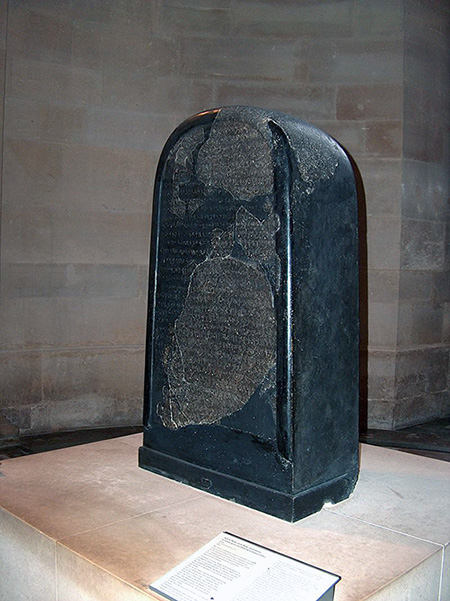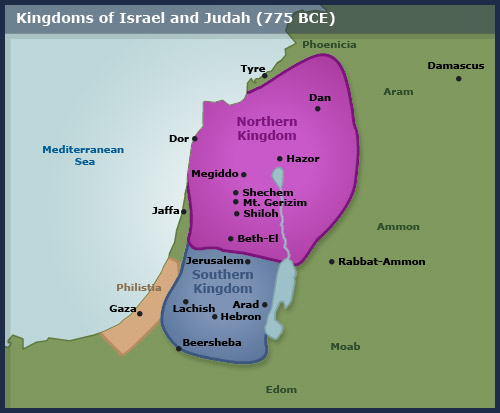After Solomon‘s death, representatives of the northern tribes demanded the implementation of reforms, which Rehoboam promised them. He was Solomon’s son. Since Rehoboam did not fulfill his promise, ten of northern tribes refused to recognize him as the ruler. North kept the name Israel and proclaimed Jeroboam, the former leader of the rebellion against Solomon, to be the king. Only tribes Judea and Benjamin remained faithful to him. After the separation, the Egyptian ruler, Shoshenq I, tried to restore the Egyptian authorities in the southern Canaan (Palestine), which resulted in great destruction on the territory of both kingdoms. Although power was not restored, Israel and Judah have weakened.
The capital of Judea has continued to be Jerusalem, and the Temple of Solomon remained the center of worshiping. On the other hand, Jeroboam (930-910 BC) decided to build a new capital, as well as a religious center. The Old Testament says that in Bethel and Dan he built shrines dedicated to Yahweh.
JUDEA: During the next period, the authorities in Judea were stable, and on the throne took turns descendants of David‘s bloodline. Judah was territorially smaller, less populated, poorer, and therefore less attractive to invaders.



ISRAEL: The situation in Israel was not stable. There have been several changes of dynasty. Besides that, the wealth of Israel and the closeness of Phoenician cities and Damascus made him attractive to Syrians and Assyrians. With the arrival of Omri (885-874 BC) on the throne, Israel will reach its peak. He was one of the military commanders who managed to establish unity and stability; also, he terminated the series of upheavals and uprisings, which shook Israel since the death of Jeroboam. He built a new capital, Samaria, in the center of Israel. He regained control over the regions, which before he came to the throne took the ruler of Damascus. He also restored the cities Dan and Hazor, which were destroyed by the Armenians.
In order to strengthen its position in relation to the ruler of Damascus, he made alliances with Ithobaal, the ruler of Tyre. He also ended the conflict with Judah, which for a long time exhausted both kingdoms, and he made an alliance with Judea’s ruler. In these conflicts, the dominant role had Israel. The alliance has been strengthened with the marriage between Omri’s daughter and Judah’s king Jehoshaphat son.
Ahab (873-851 BC) succeeded Omri. He continued the policy of his father and made Israel one of the strongest countries in the region. His army took part in the coalition who clashed with Shalmaneser III in 853 BC, in the battle of Qarqar. In addition, during his rule the economy of Israel strengthened as well.



The Old Testament texts show Ahab as a very negative person, and he is portrayed as someone who behaves in a despotic way. His main sin was that he allowed his wife to built temples and shrines to foreign deity in Israel. Citizens could not accept that, which resulted in the desecration of temples and shrines. Queen Jezebel remained influential during the reign of her sons Ahaziah (852-851 BC) and Joram (851 – 841 BC). Ahaba’s heirs were unable to cope with the problems that have multiplied. First Moab land rebelled, and the country gained independence. When 845 BC, on the throne of Damascus came Hazael, it sparked an old enmity between these two rivals. In 842/1 BC Aramaic army was moving to the south, and clashed with the Israelites and their allies Judeans. All these conflicts have brought defeat to Israel. On Hazael’s Stele of victory, it was noted that the king of Damascus killed the kings of Israel and Judah. On the throne was to Israel came Jehu (841-813 BC), one of the military commanders. He ordered the massacre of all the surviving descendants of the Omri royal family dynasty, as well as some members of the Judah royal family. When news of Jehu’s usurpation, Joram’s and Ahaziah’s death came to Jerusalem, Ahaziah’s mother, Queen Athaliah, the only surviving descendant of Omri bloodline, decided to take control of Judea. Athaliah (841-835 BC) was the only monarch of Judah, who was not a descendant of David.
Her reign ended violently, and power was transferred to Jehoahaz, the only surviving son of her husband, which meant the return of the old dynasty to the throne of Judea. During the last decades of the IX century, the Armenians had the power over Judah and Israel. Then, during the long reign of Jeroboam II (782-747 BC) Israel has regained the area east of the Jordan which Hazael took, and spread its authority on the territory of Syria. In Judah, the reign of Uzziah (767-739 BC) also made stable conditions. The decades that followed will bring many changes in the north and the south.
The fall of Samaria, Israel’s capital, took place in 721 BC. Israel has become the province of Assyria, and Judah has preserved its independence, but it had to pay to the Assyrians huge tax.
